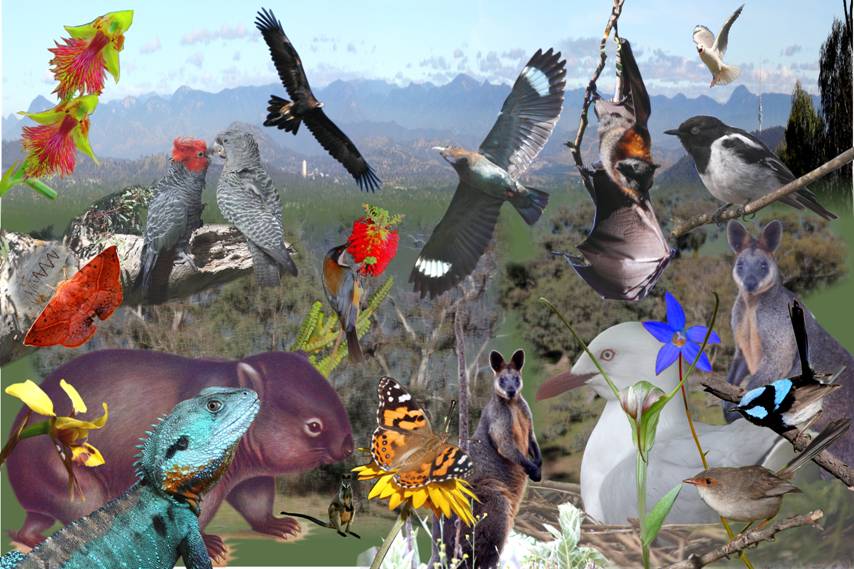Final meeting of the Special Projects Team commissioned to
design a new postage stamp showing Canberra’s wildlife.
WAYNE: Before Barry gets here for our little
celebration drinks, I might say there’s been some last-minute redesign
work. I’ll just outline the late changes. First, we almost forgot
the compulsory reptile. I’ve got to say that was your fault
Trevor. You were the reptile person from the first meeting, and now
I’ve had to go and do all the work of finding that eastern water dragon
as it’s called.
TREVOR: Gee, it looks a bit brightly coloured, Wayne
WAYNE: It is traditional in digital photography,
Trevor, to over-colour water dragons. If this one was any duller it would
be about the dullest water dragon photo I’ve ever seen. Now,
Fiona’s moth ....
FIONA: I’m so sorry, Wayne but I should never
have mentioned that scribbly gum. Nobody will give me the right moth
picture and the best I can do is that one there that I photographed myself
yesterday.
WAYNE: No worries, Fi, you’ve been a big help,
and Trevor, I must say ‘well done’ on your fruit bat. Great
idea and a pretty good picture. Now for my part I’m very pleased
I’ve finally got to the bottom of that spotty winged bird. It
definitely occurs in Canberra, and it’s called a dollarbird, because the
early colonists thought the spots looked like big silver dollars. So
there’s a great opportunity for a bit of symbolism. We can put the
bird centre-stage and say it represents the central role of money in
Canberra’s economy, in fact for the whole of Australia if it comes to
that, and even the world as a whole now I think about it.
FIONA: That’s terrific Wayne.
TREVOR: Yeah, although the symbolism will be a bit
lost on people who unlike us are unfamiliar with the bird’s name and the
reason for the spots.
WAYNE: Here comes Barry so I’ll unveil the
picture. Da-dah!!

WAYNE: Welcome Barry. On behalf of the
team I’d like to thank you for your support and guidance, and
particularly thank your wife whose great photographic skills have contribute
enormously to this typical scene of Canberra in the early morning with the
Brindabellas looming over slumbering woodlands teeming with wildlife.
BARRY: Thank you Wayne, and well done to the
team. I can announce that this wonderful scene will not only be on a
postage stamp, but produced as a postcard and also a poster.
WAYNE: We anticipate that there might be a few
questions, so to help you and the minister deal with them we have prepared this
brief on “Answers to Likely Questions”:
Q: What is that bat doing there?
A: That bat, known as a flying fox, is now abundant in
Canberra. For many Canberrans a picnic under the trees in Commonwealth
Park, with the flying foxes overhead, is a highlight of the warmer months.
Q: What is that seagull doing there?
A: Canberra’s Lake Burley Griffin is home to an
important breeding colony of this familiar species.
Q: Why is that lizard that funny colour?
A: Male eastern water dragons are highly coloured in
the breeding season. The one illustrated is a large angry male at the
height of the season.
Q: Why don’t I see wombats in Kaleen?
A: As with all wildlife, your chances of coming across
any particular species depends on the time of year, the time of day, and
whether you are in suitable habitat. You may not be getting up early
enough in the morning, or it may be that the habitat requirements for this
species are not satisfied in your particular area.
Q: Are those kangaroos?
A: No. They are Swamp Wallabies, which some
people confuse with kangaroos.
Q: Why are there no kangaroos in the picture?
A: The use of the eastern grey kangaroo in official
government publications is the subject of a review in which all interested
parties will be consulted. Pending the outcome of that review it is
considered preferable not to use the eastern grey kangaroo in official
government publications.
Q: Are there any plans to cull Swamp Wallabies?
A: There are no current plans
Q: Is that the moth that causes the scribble on
Scribbly Gums?
A: A moth definitely causes the scribble on Scribbly
Gums. That moth might or might not be the one. The purpose of this
composition is to foster an interest in wildlife and get the public to ask
questions and go out into the bush to seek the answers for themselves.
BARRY: Thanks Wayne, great work.
[This is the end of this miniseries]

